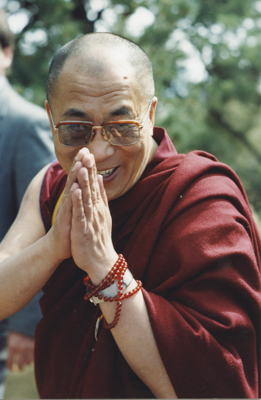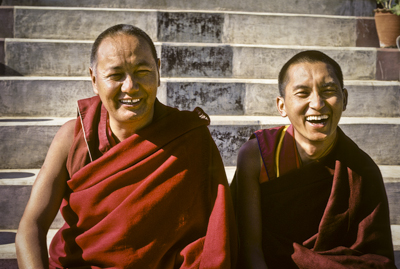Dear Friends,
I hope you are well. And as another year draws to a close, we want to thank you again for your interest in and support of the Lama Yeshe Wisdom Archive and to ask you to keep it going in 2008. We have some wonderful projects coming up and will keep you informed of them monthly through the medium of our e-letter. And as I always ask, please share it with your friends, Dharma center newsletter, website etc.
Year-End Appeal Recently we emailed you an end-of-year appeal and sent a similar letter by regular mail to our members and benefactors, and I would like to thank from the bottom of my heart all those who responded with a contribution. If you have not yet had a chance to do so, please do. It is only through the generous support of our members and benefactors that we are able to spread the Dharma, the true cause of happiness for all beings, freely all over the world. Thank you so much.
Recently we emailed you an end-of-year appeal and sent a similar letter by regular mail to our members and benefactors, and I would like to thank from the bottom of my heart all those who responded with a contribution. If you have not yet had a chance to do so, please do. It is only through the generous support of our members and benefactors that we are able to spread the Dharma, the true cause of happiness for all beings, freely all over the world. Thank you so much.
Due to the kindness of our members and benefactors, we will be printing three books in January: Lama Yeshe’s Universal Love: The Yoga Method of Buddha Maitreya and Lama Zopa Rinpoche’s How Things Exist: Teachings on Emptiness and Making Life Meaningful (reprint). We’ll let you know when they are finally available.
Excellent Links on the Web
Recently we received a Thanksgiving “news bulletin” from Lama Zopa Rinpoche’s residence in California, Kachoe Dechen Ling, describing the Dharma Thanksgiving celebrations there. Food for thought for future years. You can find a link to it at the top of Lama Zopa Rinpoche's Advice page on the FPMT website.
We all get emailed links to this and that from our friends; me too. Most of them don’t amount to much: a bit of a laugh, a touch of incredulity and then that’s it. But recently I received a couple that were a bit more thought-provoking and as they both express sentiments consistent with the Dharma I’d like to share them with you here. The first suggests an approach to the global climate crisis; the second extols the virtues of non-consumerism and content.
Words from His Holiness the Dalai Lama One of the other items I get regularly in my email is Snow Lion Publications’ Dalai Lama Quote of the Week. Here’s a recent one that I’d also like to share:
One of the other items I get regularly in my email is Snow Lion Publications’ Dalai Lama Quote of the Week. Here’s a recent one that I’d also like to share:
[Preceding story: Before reaching enlightenment, the Buddha was born as Prince Visvantara, who, despite facing many challenges and adversity, brought all of his heart and courage to bear against a single enemy—human suffering.]
In giving we not only find wealth while in cyclic existence but we achieve the zenith of prosperity in supreme enlightenment. Therefore we all have to practice giving. A bodhisattva’s giving is not just overcoming miserliness and being generous to others; a pure wish to give is cultivated, and through developing more and more intimacy with it, such giving is enhanced infinitely.
Therefore it is essential to have the firm mind of enlightenment rooted in great love and compassion and, from the depths of one’s heart, to either give one’s body, wealth and virtues literally to sentient beings as infinite as space, or to dedicate one’s body, wealth and virtues for them while striving in all possible ways to enhance the wish to give infinitely. As mentioned in Guide to the Bodhisattva’s Way of Life and The Precious Garland, we should literally give material help to the poor and needy, give teaching to others, and give protection to them, even the small insects, as much as we can. In the case of things that we are not able to part with, we should cultivate the wish to give them away and develop more and more intimacy with that wish.
—from Generous Wisdom: Commentaries by H.H. the Dalai Lama XIV on the Jatakamala, translated by Tenzin Dorjee, edited by Dexter Roberts.
Best Wishes
This week’s teaching comes from a book that we will be publishing next year, an incredible compilation of Lama Zopa Rinpoche’s teachings on guru devotion, edited by Ven. Ailsa Cameron, who has been editing Rinpoche’s teachings for over twenty years and was instrumental in the development of the Archive in its early years.
Thank you again so much for your kindness, and all of us at the LYWA wish you the very best for the holiday season, 2008 and infinitely beyond.
Much love,
Nick Ribush
Director
The Root of the Path
 In the lamrim, or graduated path to enlightenment, the first meditation outline is the root of the path: how to devote to the virtuous friend. Why is guru devotion the root of the path to enlightenment? Enlightenment is like a ripe fruit, the path to enlightenment is like the trunk of a tree, and guru devotion is like the root of the tree. From the root of guru devotion, the trunk of the path grows in our mind and bears the fruit of enlightenment. Whether or not we can start to develop the path to enlightenment in our mind in this life is determined by our practice of guru devotion.
In the lamrim, or graduated path to enlightenment, the first meditation outline is the root of the path: how to devote to the virtuous friend. Why is guru devotion the root of the path to enlightenment? Enlightenment is like a ripe fruit, the path to enlightenment is like the trunk of a tree, and guru devotion is like the root of the tree. From the root of guru devotion, the trunk of the path grows in our mind and bears the fruit of enlightenment. Whether or not we can start to develop the path to enlightenment in our mind in this life is determined by our practice of guru devotion.
Proper devotion to the guru, or virtuous friend, is the root of all success, from success in this life up to enlightenment, just as the trunk, branches, leaves and fruit of a tree depend upon its root. Or we can think that guru devotion is like the fuel in a car or a plane, without which the vehicle cannot take us where we want to go. Without guru devotion, nothing happens—no realizations, no liberation, no enlightenment—just as without the root of a tree there can be no trunk, branches, leaves, or fruit. Everything, up to enlightenment, depends on guru devotion.
Guru devotion is the root not only of ultimate success, achieving full enlightenment and bringing sentient beings to the ultimate happiness of liberation and enlightenment, but also of temporary success and happiness. This practice is the foundation of the development of the whole path to enlightenment, as well as the foundation of all happiness. Since everything comes from the practice of guru devotion, it is called the root of the path.
Wise practitioners, those who know how to practice Dharma skillfully, give their full attention day and night to this point of correctly devoting to the virtuous friend. His Holiness Serkong Dorje Chang, who lived at Swayambhunath in Nepal, once told his monks, “If you do the practice of devoting yourself to the virtuous friend well, everything will be fine, even if you don’t study. You can relax and have a good time, just eating and sleeping. You can enjoy life.” Rinpoche expressed the very heart of Dharma practice. If we practice guru devotion well, we can enjoy life in the best way, because our practice brings all success and stops all obstacles.
The answer to how quickly and easily we will achieve realizations of the path to enlightenment depends on our finding a qualified virtuous friend, and after having found him*, how well we devote ourselves to him. Before devoting ourselves to a guru, we should check him well; then after we have made the Dharma connection, we correctly devote ourselves to him with thought and with action. Devoting with thought means seeing the guru as a buddha, an enlightened being, by looking at him in that way; and devoting with action means carrying out the guru’s advice, serving and making offerings to him.
The main meditation subject of guru devotion is actually contained in devoting to the guru with thought. Using scriptural quotations, logic and our personal experiences of the guru, we look at the guru as a buddha, as having ceased all faults and possessing all good qualities. At the beginning we use analytical meditation with quotations and logic to prove to the mind that doesn’t see the guru as a buddha that they are a buddha, thus transforming this mind into the pure thought of devotion.
At first, when we are not actually doing analytical meditation on guru devotion, that feeling of devotion quickly disappears. However, through meditation, after some time the experience becomes stable. When we have some experience, some feeling in our heart that our guru is a buddha, even if it lasts just a short time, it is a sign of receiving the blessings of the guru. When we then come to spontaneously and constantly see the guru as a buddha, we have developed the realization of guru devotion.
Devotion brings blessings. From guru devotion, we receive the blessings of the guru in our heart, and from those blessings, realizations of the path to enlightenment manifest from within our mind. Our devotion makes it possible for us to achieve enlightenment, to cease all the faults of our mind and to complete all the realizations. This then enables us to do perfect work for the numberless other sentient beings, liberating them from the oceans of samsaric sufferings and bringing them to liberation and enlightenment. This is why guru devotion, this experience of seeing the guru as a buddha, is the root of the path to enlightenment.
Through the practice of guru devotion, looking at our guru as inseparable from a buddha or our own special deity, the blessings of the guru enter our heart. Devotion is the opening through which the nectar of the guru’s blessings enters us. Without guru devotion practice, the nectar of the guru’s blessings doesn’t enter our mind and this makes it very difficult for us to generate realizations of the path to enlightenment. Just as a seed cannot grow without water, our mind cannot develop without blessings. Without blessings, our mind is like a hot desert where nothing grows. No matter how much we meditate on the path, no matter how much we squeeze, nothing will grow.
The guru’s blessings transform our mind from being hard and unsubdued into being soft and subdued. Even from our own experiences, we can tell that what the teachings say about the blessings of the guru is true and have complete faith in it. When we have strong guru devotion in our heart, if we meditate on perfect human rebirth, we feel its preciousness very easily; if we meditate on impermanence and death, we feel the transitory nature of life very strongly and easily; and the same thing happens if we meditate on compassion, emptiness or any other lamrim topic. In a state of strong devotion, our mind is also calmer, more subdued. Our delusions arise only with difficulty and are easy to control.
When our devotion degenerates or disappears, our delusions arise very strongly and are more difficult to control; it is also more difficult to have any feeling for impermanence and death, compassion or bodhicitta. We can check this from our own experiences. At times when our mind is very hard and skeptical, with no devotion, do we find it easy or difficult to meditate on lamrim? And at times when we feel strong devotion, how do we feel when we meditate on the path?
When we have strong meditation experiences, ones that change our mind, we feel even more deeply the kindness of the virtuous friend and develop more devotion toward him. That developing realizations depends on guru devotion is not simply something made up so that gurus receive more respect, service and offerings. We can clearly see the truth of this from our own experiences.
Without the foundation of the devotion that sees the guru as a buddha, there is no basis for Dharma practice. It is like trying to taste artificial fruit. The blessings of the guru enable us to achieve the realizations of the graduated path to enlightenment. On the basis of the three principal paths, we then practice tantra and achieve the generation and completion stages of Highest Yoga Tantra. We are then able to achieve enlightenment in this life, or within three or sixteen lifetimes.
Achieving tantric realizations especially depends on guru devotion. By practicing the lower tantras—Action, Performance and Yoga tantras—we can achieve enlightenment in one lifetime, but only by obtaining the “immortality” siddhi, which enables us to live for thousands of years and thus achieve enlightenment. However, without needing to prolong our life in this way, by practicing Highest Yoga Tantra we can achieve enlightenment in the brief lifetime of a degenerate time, even within a few years. (The term brief lifetime is used because life is much shorter in a degenerate time.) It was mainly by doing special guru yoga practice that the great yogi Milarepa, as well as many other Tibetan yogis and Indian pandits, were able to achieve tantric realizations within a few years and thus achieve enlightenment in one brief lifetime.
In Highest Yoga Tantra, guru yoga is practiced as the heart of the path. To achieve enlightenment in this brief lifetime, we have to cherish guru yoga practice like our own life. It is only then that practicing the Six Yogas of Naropa and other tantric techniques becomes the quick path to enlightenment. Otherwise, if we don’t cherish guru yoga as more precious than our own life, no matter how many years we meditate on the Six Yogas of Naropa, nothing will happen. With strong guru yoga practice, however, we can succeed in the Highest Yoga Tantra path and achieve the unified state of Vajradhara in this life, just as those past great yogis did.
Guru yoga is the fuel that makes Highest Yoga Tantra the quick path to enlightenment. If there is no fuel in a plane, the people in the plane can’t reach the place they want to go; if there is fuel, they can. The guru yoga practice in Highest Yoga Tantra is special fuel, more special than that of the Hinayana, Paramitayana and even the lower tantras.
Excerpted from Lama Zopa Rinpoche’s The Heart of the Path: Seeing the Guru as Buddha, edited by Ven. Ailsa Cameron, to be published by the Lama Yeshe Wisdom Archive in 2008.
*NOTE: Or her. Unfortunately, the only impersonal third person pronoun English language offers us is “it,” and that doesn’t seem appropriate for a human being, much less a guru. It’s too cumbersome to write “him or her” every time and alternating the two seems overly PC. Using “them” is just grammatically incorrect. Since most gurus are male, we’ve settled on “him”; if you have a female guru you’re thinking of, read “her.” [Return to text]































